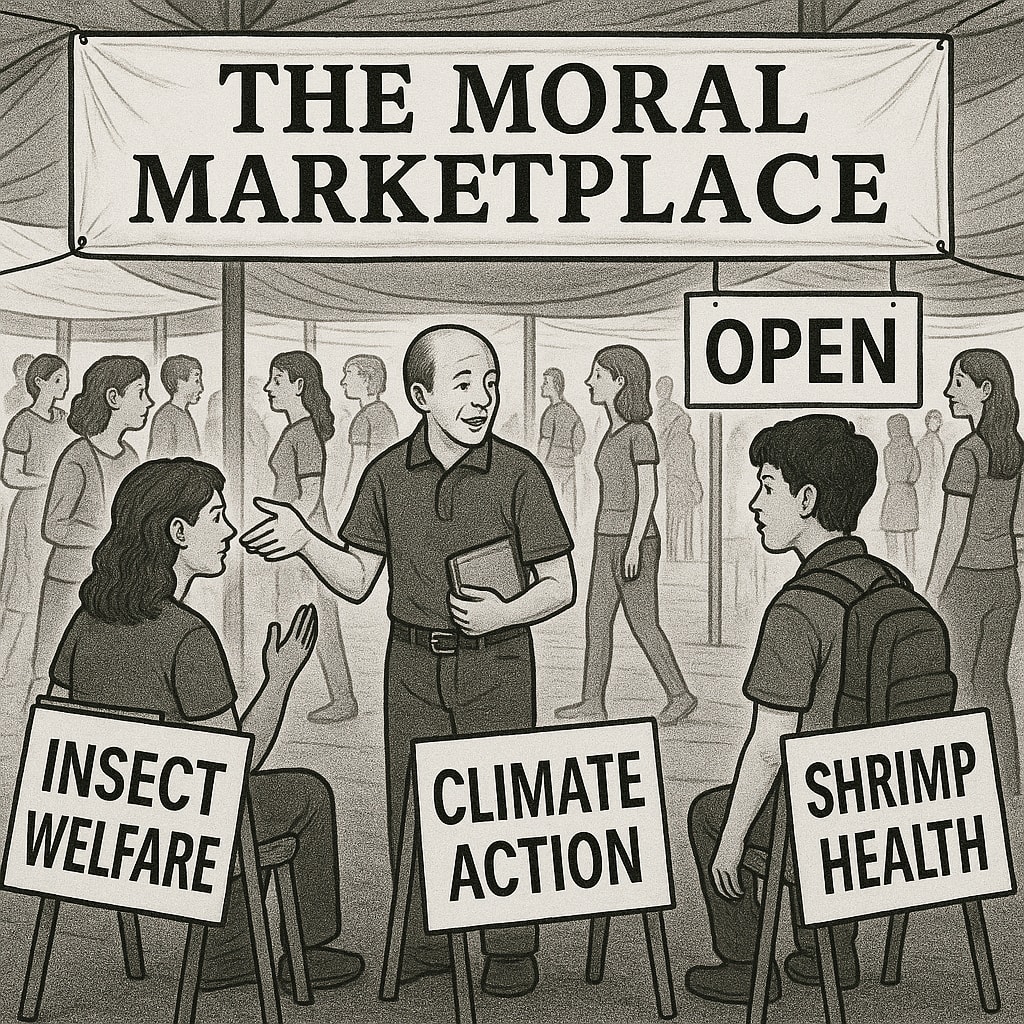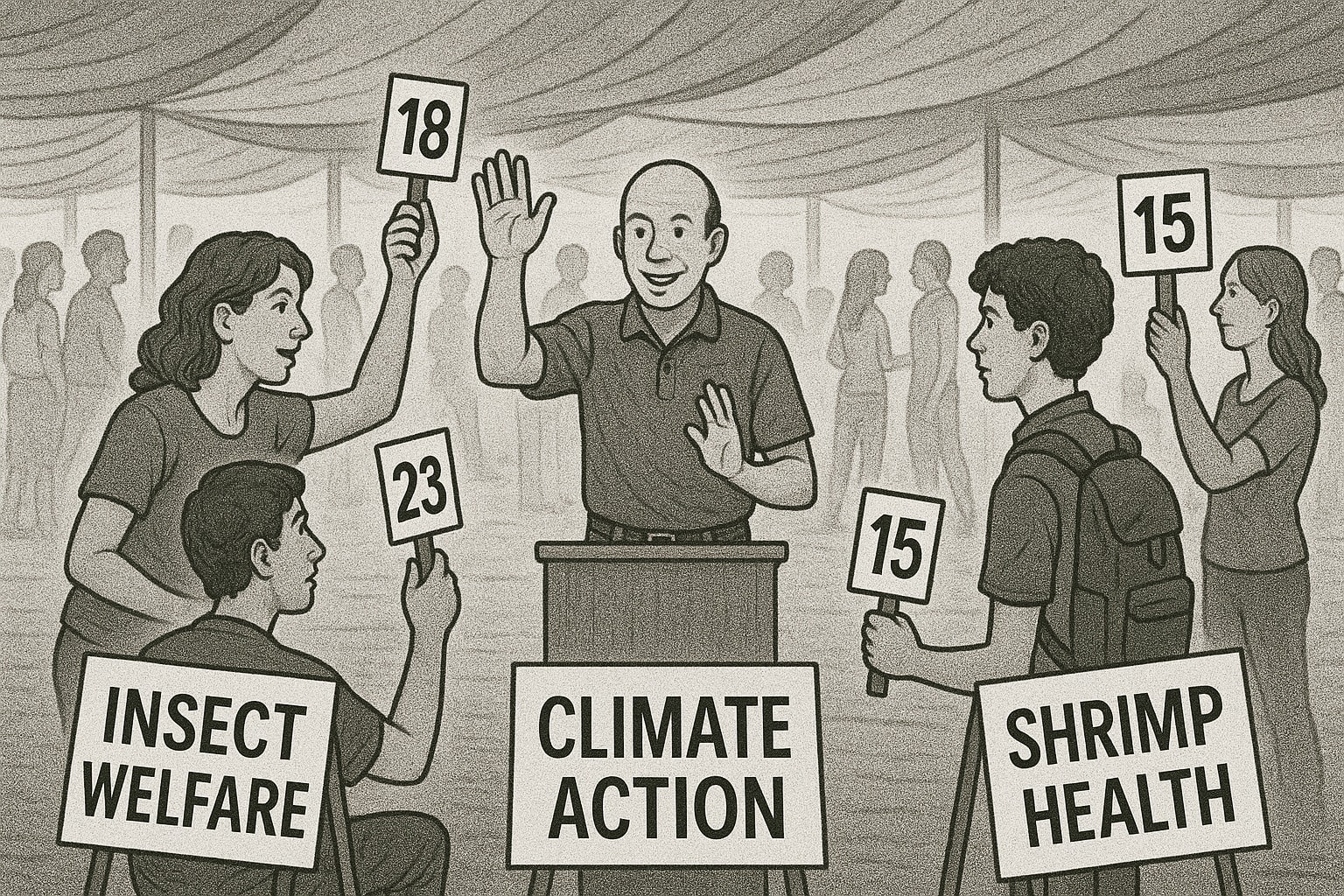
In my previous piece, I revisited the central claim of this “Buying Good” series and concluded that its core prediction (that Effective Altruism would inevitably revert to “effective giving” as its dominant mode of engagement) was overly sweeping and based on an overly insular understanding of the moral economy in which Effective Altruism functions.
While I rightly challenged the internal coherence of my earlier argument, merely establishing that such an outcome is not inevitable does not, in itself, suffice to show that internal competition will be meaningfully diffused, or that a renewed emphasis on “effective giving” will not still emerge as a dominant pattern of engagement.
The conclusion of that piece merely demonstrated that “effective giving” need not be the primary mechanism for “doing good” within Effective Altruism. It did not preclude the possibility that “effective giving” may nonetheless experience a resurgence, even if not as the movement’s central paradigm. And so, here I am returning for round two. I intend to defend the position once more, albeit in a more tempered form.
When we examine the internal dynamics of symbolic capital that shape the Effective Altruism ecosystem, the possibility that “effective giving” may still experience a resurgence becomes a likelihood.
In my previous piece, I identified a critical oversight in my original argument. Nonetheless, while it was used to expose a flaw in my reasoning and thereby weaken my initial claim, this paper surfaced an important and previously unexamined insight: namely, the presence of external funding streams entering the Effective Altruism ecosystem, distinct from the movement’s internal sources. In what follows, I aim to demonstrate that this fact alone does not entail a diffusion of internal competition within Effective Altruism. On the contrary, I argue that the introduction of external capital may, in subtle yet significant ways, intensify the very dynamics of strategic competition that I used as a justification for the marketplace thesis.
When particular causes within Effective Altruism attract high-profile external attention (whether from major philanthropists, governments, or corporate partners) they gain more than just financial resources. They acquire symbolic capital: legitimacy, visibility, and perceived moral urgency. This capital, once accrued, will be reinvested back into the Effective Altruism space, where it functions as a reputational asset that can consolidate influence, attract talent, and justify further internal investment. Rather than flattening the landscape of cause prioritisation, external validation will stratify it further, reinforcing existing hierarchies and exacerbating the competition between initiatives within the community.
Areas such as global poverty alleviation and public health intervention have long been embedded within both national and international policy agendas. For decades, they have occupied a central place in public discourse, bolstered by sustained media attention and institutional endorsement. These cause areas are intimately tied to widespread cultural conceptions of altruism and moral responsibility. For the average person, they often represent the paradigmatic expression of “doing good”, not only due to their perceived urgency, but also because of the normative narratives that have shaped their public visibility over time. Naturally, individuals who encounter Effective Altruism will be inclined to gravitate toward cause areas such as global poverty alleviation and public health intervention, given the widespread societal legitimacy and cultural familiarity these domains already enjoy outside of the movement. But it doesn’t end there.
Cause areas such as AI safety, veganism, and animal rights are closely aligned with specific cultural, educational, and disciplinary trajectories.
AI safety appeals strongly to individuals with backgrounds in quantitative and technical fields, such as mathematics, computer science, and engineering, who are already attuned to the epistemic, ethical, and policy challenges posed by advanced technologies. These pathways are increasingly directing large numbers of individuals toward AI governance as am area of concern. Naturally, among those who encounter Effective Altruism through these channels, there is a high likelihood of gravitating toward AI-related cause areas within the movement.
Not dissimilarly, interest in animal welfare and vegan advocacy is often shaped by prolonged exposure to popular discourse, particularly through influential media figures and platforms who have spent years crafting emotionally resonant and rhetorically accessible narratives around these issues. This sustained cultural visibility channels a significant number of individuals toward animal welfare as a primary moral concern. Among those who later encounter and engage with Effective Altruism, it is unsurprising that many gravitate toward Effective-Altruism-aligned animal advocacy initiatives, given the pre-existing moral commitments and ideological alignment fostered by these broader cultural influences.
The point is this: individuals rarely enter the Effective Altruism community as blank slates. Rather, they arrive with pre-existing moral commitments, many of which have been shaped by broader cultural, educational, and media environments by prior exposure to “marketed” causes throughout their upbringing. While one might assume that this diversity of background encourages pluralism within the movement, the opposite may in fact be true. These prior affiliations often predispose newcomers (and even seasoned participants) to align with the most publicly prominent and externally endorsed cause areas, thereby reinforcing existing hierarchies of attention and funding within the Effective Altruism ecosystem.
This creates a reinforcing loop where already-visible causes continue to attract resources, while others that are potentially no less philosophically grounded or empirically promising struggle to gain traction. In this way, external funding acts not as a release valve, but as an amplifier of internal competition. It contributes to a moral economy where perception and popularity begin to matter more, reinforcing the very dynamics of the “moral marketplace” I previously described.
This becomes a problem when we realise that many Effective-Altruism-supported causes don’t receive substantial attention (or any attention at all) from actors outside the Effective Altruism community.
Niche cause areas such as wild animal suffering, shrimp welfare, or synthetic sentience rights rarely intersect with mainstream philanthropic interest, policy agendas, or public consciousness. For these domains, internal funding from Effective Altruists remains essential because they aren’t getting it from elsewhere. If they are to survive, let alone flourish, they must compete directly with better-known causes within the Effective Altruism community. For these initiatives, “effective giving” is not merely one strategy among many. It is the central exclusive vehicle through which their existence is sustained.
But here’s the thing: these lesser-known cause areas are not only competing with the more prominent, externally supported initiatives within the Effective Altruism community. They are, more acutely, locked in competition with one another.
Among the relatively niche domains that receive little to no attention from outside the Effective Altruism ecosystem (such as shrimp welfare or wild animal suffering), the pool of available funding is effectively limited to Effective-Altruism-aligned individuals and institutions. In this context, the moral economy becomes more concentrated, not less. These causes must vie for visibility, credibility, and donor commitment within a finite internal landscape. The moral marketplace, therefore, reasserts itself, albeit with fewer actors competing for investment than previously assumed. The dynamics of competition persist, but now with sharper focus and intensified pressure within the boundaries of Effective Altruism itself.
In such cases, the return to “effective giving” is not merely plausible, it is structurally necessary. The competitive pressure for internal attention and funding becomes especially acute when certain cause areas are buoyed by external capital while others are left entirely dependent on the Effective Altruism donor base. The result is an intensification of intra-movement competition, not its alleviation. Far from rendering the “marketplace” metaphor obsolete, the presence of external capital reinforces it by shifting the goalposts of visibility and reallocating internal expectations of what counts as a worthwhile or fundable initiative.
So, the key revision to my argument is this: in light of these new insights, it was inaccurate to claim that the entirety of the Effective Altruism ecosystem functions as a closed moral economy, thereby subjecting all its constituent organisations to a reversion toward “effective giving” as the dominant strategy for “doing good”. This generalisation overreached. As a result, my initial prediction, that Effective Altruism as a whole is on course to return to a donation-centric paradigm, now appears overstated, if not outright mistaken. Whether I should feel mildly embarrassed or cautiously relieved is unclear; after all, my motivation in advancing this whole discussion was rooted in a genuine desire to see Effective Altruism succeed.
However, those Effective-Altruism-aligned organisations that rely exclusively on funding from within the Effective Altruism community still operate within a self-contained moral economy. Within this internal ecosystem, they are compelled to prioritise securing financial support in order to remain viable, competing not only with one another, but also for the residual attention and resources left behind by the more dominant cause areas that attract the lion’s share of investment both from within and outside Effective Altruism.
In short, the assumption of a fully open moral economy, where external actors relieve the competitive burden of internal resource allocation, is only partially true. Where it is true, it introduces new pressures. The symbolic capital derived from external endorsement does not dissolve the internal logic of competition; it recalibrates it. It changes who is seen, who is heard, and who is funded. And for those outside the spotlight, the imperative to frame their work in terms that attract internal donors remains as strong as ever, perhaps stronger.
Thus, even in an ecosystem enriched by external interest, “effective giving” may return as the dominant internal mechanism for some causes. This is not because of financial necessity in an absolute sense, but because of the structural and symbolic pressures that shape who gets to “do good” and how. The moral marketplace, in this sense, does not disappear. It becomes more complex, more subtle, and more entrenched.

Now, up to this point, I’ve presented these dynamics as if they were unintended byproducts and emergent flaws in what I had assumed to be a fundamentally collaborative vision of Effective Altruism: a global movement of individuals working together to allocate resources in the most impactful ways, grounded in open dialogue, shared deliberation, and mutual influence. But perhaps that assumption was misguided. In fact, after working through the arguments in these pieces, it now seems not only possible but increasingly plausible that Effective Altruism was never meant to function as a cooperative collective in the traditional sense.
Perhaps the movement was always intended, or at least structurally inclined, to resemble a moral marketplace: a decentralised, quasi-competitive system in which independently operating initiatives vie for influence, attention, and funding, all under a shared methodological umbrella of reason and evidence. In this light, Effective Altruism may be less a unified project and more an ideological framework that legitimises a kind of moral capitalism: one in which causes are evaluated, filtered, and either elevated or abandoned through a process that mirrors economic competition rather than democratic collaboration.
If that’s the case, then perhaps this system is Effective Altruism’s answer to the question, “What is the most effective way to do good?”. Not through consensus or solidarity, but through competition and selective survival. The fate of niche cause areas like shrimp welfare isn’t necessarily a failure of the system. It might be the system working as intended.
If this interpretation holds any truth, it raises important questions about why this market-oriented logic is not made more explicit within the movement’s public discourse. If Effective Altruism truly operates as a moral marketplace, it should be stated openly, if only to avoid essays like this one: long, analytical attempts to decode the unspoken architecture of the movement. There’s much more to explore here. So, on that note, I’ll leave it there for now. See you in the next one.
